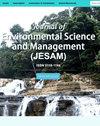Lead Uptake of the Asian Clam (Corbicula fluminea), Nile Tilapia (Oreochromis niloticus) and its Parasite (Acanthogyrus sp.) in Yambo Lake, Laguna, Philippines
IF 0.3
4区 环境科学与生态学
Q4 ENVIRONMENTAL SCIENCES
引用次数: 0
Abstract
The contamination of heavy metals in the aquatic environment poses a threat due to its persistence and potential accumulation in aquatic life forms. In order to detect such pollution, the use of organisms as bioindicators was explored. This study investigated the use of fish acanthocephalan parasites as bioindicator of lead (Pb) in a semi-pristine Yambo Lake in San Pablo, Laguna, Philippines. Lake water samples, wild Nile tilapias (Oreochromis niloticus), its acanthocephalan parasites (Acanthogyrus sp.), and Asian clams (Corbicula fluminea) were collected and subjected to Pb concentration detection through heavy metal analysis. Higher accumulated mean concentration levels of Pb is recorded in Acanthogyrus sp. (10.13 mg kg-1), followed by the fish host tissues: liver (6.19 mg kg-1), intestine (2.80 mg kg-1), and muscle (0.75 mg kg-1). An established bioindicator, C. fluminea, only accumulated an average of 0.16 mg kg-1 Pb in its soft tissues. The bioaccumulation capacity of Acanthogyrus sp. to the fish host and water samples were 35 times higher than the liver, 190 times the intestine and 211 times than the muscle. Furthermore, the accumulated Pb in the parasite was 3,015 times higher than C. fluminea in lake water. Among all samples analyzed, Acanthogyrus sp. showed the highest accumulation capacity. These findings provide useful information to the bio indicator potential of this parasite, and that local environment authorities can utilize its sensitivity to detect and monitor traces of heavy metals even in less polluted aquatic environments.菲律宾拉古纳Yambo湖亚洲蛤(Corbicula fluminea)、尼罗罗非鱼(Oreochromis niloticus)及其寄生虫(Acanthogyrus sp.)对铅的吸收
由于重金属在水生生物中的持久性和潜在蓄积性,对水生环境的污染构成了威胁。为了检测这类污染,探索了利用生物作为生物指标。本研究在菲律宾拉古纳圣巴勃罗半原始的Yambo湖中研究了鱼棘头虫作为铅(Pb)的生物指示物。采集湖泊水样,野生尼罗罗非鱼(Oreochromis niloticus)及其棘头虫(Acanthogyrus sp.)和亚洲蛤(Corbicula fluinea),通过重金属分析检测其Pb浓度。棘棘鱼(Acanthogyrus sp.)的累积平均铅浓度较高(10.13 mg kg-1),其次是鱼类宿主组织:肝脏(6.19 mg kg-1)、肠道(2.80 mg kg-1)和肌肉(0.75 mg kg-1)。已建立的生物指示剂氟化c.f uminea在其软组织中平均仅积累0.16 mg kg-1 Pb。棘棘鱼对鱼宿主和水样的生物蓄积能力是肝脏的35倍,肠道的190倍,肌肉的211倍。此外,该寄生虫体内Pb的累积量是湖泊水体中氟化弓形虫的3015倍。在所有样品中,棘棘鱼的积累能力最强。这些发现为这种寄生虫的生物指示潜力提供了有用的信息,地方环境当局可以利用其敏感性来检测和监测即使在污染较少的水生环境中痕量的重金属。
本文章由计算机程序翻译,如有差异,请以英文原文为准。
求助全文
约1分钟内获得全文
求助全文
来源期刊

Journal of Environmental Science and Management
ENVIRONMENTAL SCIENCES-
CiteScore
0.90
自引率
0.00%
发文量
10
审稿时长
2 months
期刊介绍:
The Journal of Environmental Science and Management (JESAM) is an international scientific journal produced semi-annually by the University of the Philippines Los Baños (UPLB).
JESAM gives particular premium to manuscript submissions that employ integrated methods resulting to analyses that provide new insights in environmental science, particularly in the areas of:
environmental planning and management;
protected areas development, planning, and management;
community-based resources management;
environmental chemistry and toxicology;
environmental restoration;
social theory and environment; and
environmental security and management.
 求助内容:
求助内容: 应助结果提醒方式:
应助结果提醒方式:


